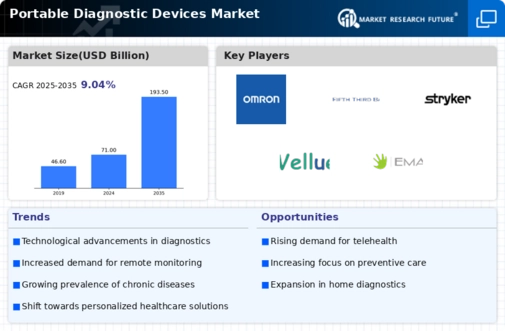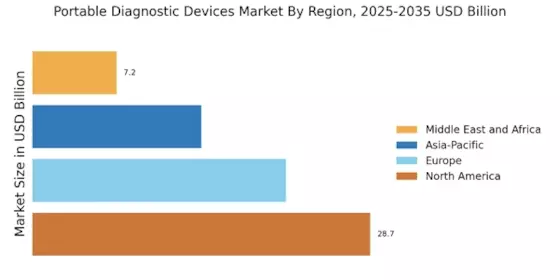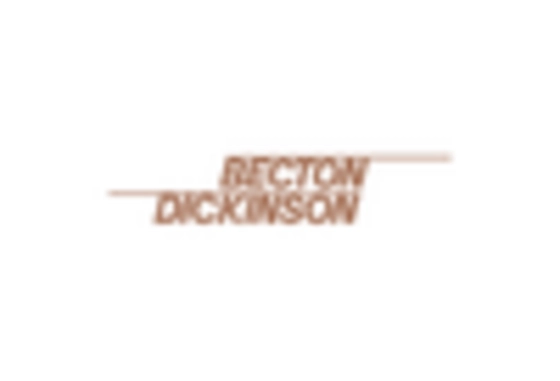Focus on Preventive Healthcare Initiatives
The Portable Diagnostic Devices Market is increasingly aligned with the global focus on preventive healthcare initiatives. Governments and health organizations are promoting early detection and management of diseases to reduce healthcare costs and improve patient outcomes. Portable diagnostic devices play a pivotal role in this paradigm shift, enabling individuals to monitor their health proactively. For example, wearable devices that track vital signs can alert users to potential health issues before they escalate. As a result, the market for these devices is projected to grow, with estimates suggesting a rise in adoption rates among consumers. This focus on prevention is likely to drive innovation and investment in the portable diagnostic devices sector.
Increased Demand for Remote Monitoring Solutions
The Portable Diagnostic Devices Market is witnessing a notable increase in demand for remote monitoring solutions. This trend is largely driven by the growing prevalence of chronic diseases and the need for continuous patient monitoring. Devices that enable remote diagnostics allow healthcare providers to track patient health metrics from afar, thereby reducing the need for frequent hospital visits. Market data indicates that the remote patient monitoring segment is expected to grow significantly, with estimates suggesting it could account for over 30% of the portable diagnostic devices market by 2025. This shift towards remote monitoring not only enhances patient convenience but also optimizes healthcare resource allocation.
Integration of Artificial Intelligence in Diagnostics
The Portable Diagnostic Devices Market is increasingly integrating artificial intelligence (AI) technologies to enhance diagnostic accuracy and efficiency. AI algorithms can analyze vast amounts of data, providing healthcare professionals with insights that improve decision-making processes. This integration is particularly beneficial in portable diagnostic devices, where quick and accurate results are paramount. Recent studies suggest that AI-enhanced diagnostic tools could reduce diagnostic errors by up to 30%, thereby improving patient outcomes. As the healthcare sector continues to embrace digital transformation, the demand for AI-driven portable diagnostic devices is likely to grow, positioning these technologies as essential components in modern healthcare delivery.
Rising Geriatric Population and Associated Health Issues
The Portable Diagnostic Devices Market is significantly influenced by the rising geriatric population, which is often associated with various health issues requiring regular monitoring. As the global population ages, the demand for portable diagnostic devices that cater to the unique health needs of older adults is expected to increase. This demographic shift is prompting healthcare providers to seek efficient solutions for managing chronic conditions prevalent among seniors. Market analysis indicates that the elderly population is projected to reach 1.5 billion by 2050, thereby expanding the market for portable diagnostic devices tailored for this age group. This trend underscores the necessity for innovative diagnostic solutions that enhance the quality of care for older patients.
Technological Advancements in Portable Diagnostic Devices
The Portable Diagnostic Devices Market is experiencing a surge in technological advancements that enhance device functionality and user experience. Innovations such as miniaturization, improved sensor technology, and integration with mobile applications are driving this growth. For instance, the introduction of point-of-care testing devices has revolutionized diagnostics, allowing for rapid results in various settings. According to recent data, the market for portable diagnostic devices is projected to reach USD 25 billion by 2026, reflecting a compound annual growth rate of approximately 10%. These advancements not only improve diagnostic accuracy but also facilitate real-time data sharing, which is crucial for timely medical interventions.


















Leave a Comment